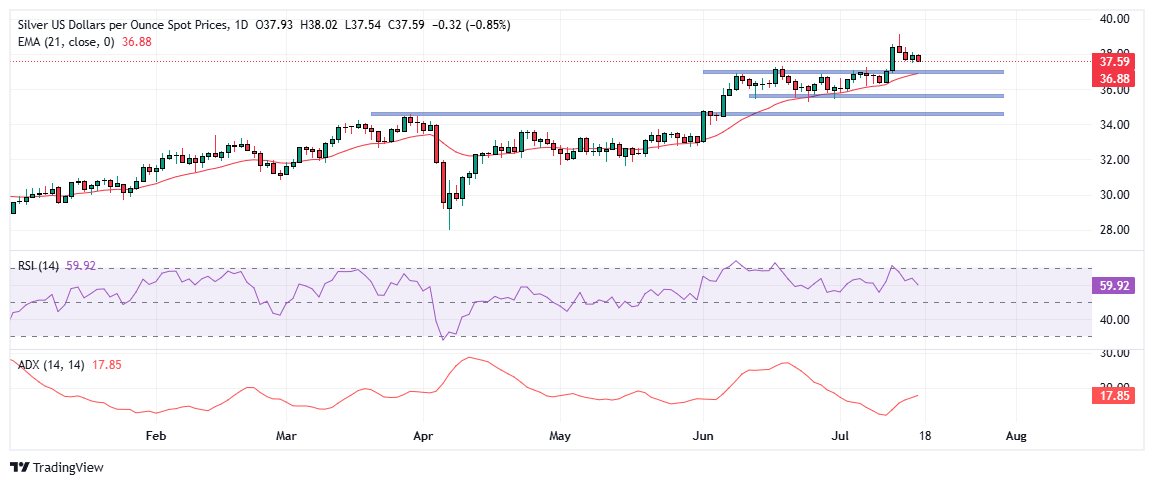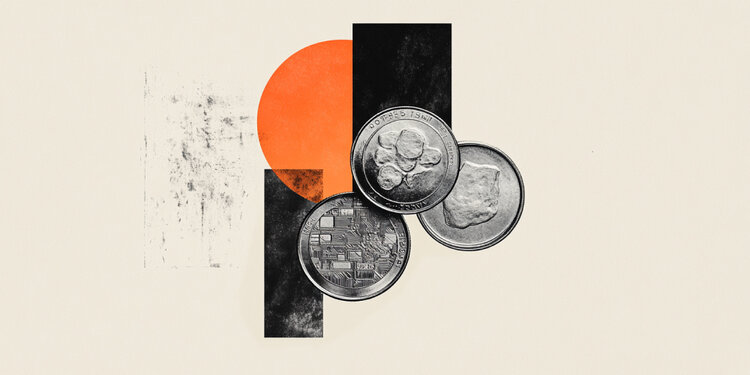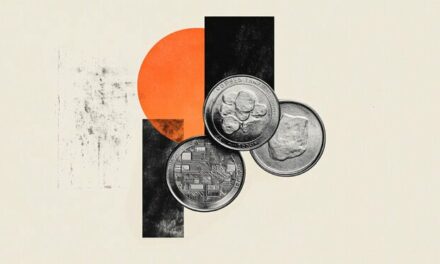- Silver declines on Thursday following a modest 0.56% gain on the previous day.
- The uptrend remains intact, with price holding above the 21-day EMA at $36.91.
- The RSI is easing from overbought levels, suggesting waning bullish momentum.
Silver (XAG/USD) is edging lower on Thursday, trading around $37.57 after logging a modest gain of nearly 0.56% on Wednesday. The metal remains elevated after marking a 14-year high of $39.13 earlier this week, but momentum has cooled as the price consolidates just below that peak.
A stronger-than-expected US Retail Sales report for June, which showed a 0.6% monthly rise versus the 0.1% forecast, boosted the US Dollar and Treasury yields, putting mild pressure on Silver. Traders are now watching to see whether the uptrend can resume or if a deeper pullback is on the horizon.

On the technical front, Silver remains in an established uptrend, with the price holding firmly above the 21-day Exponential Moving Average (EMA), currently at $36.91. This moving average continues to act as dynamic support, reinforcing the short-term bullish bias. However, the metal has stalled just below the key resistance zone near $39.00-$39.13, where sellers emerged and capped upside attempts.
The Relative Strength Index (RSI) is easing from near the overbought zone, now hovering around 63.42, after spot prices touched multi-year highs earlier this week. This signals a waning of bullish momentum and a possible pause or pullback in the rally, unless new drivers emerge. Meanwhile, the ADX (Average Directional Index) remains low at 17.85, indicating a lack of strong trend conviction despite the bullish trend.
Immediate support is seen around $37.00 round number, aligning with the 21-day EMA and marking a key line in the sand for bulls. A break below this level could trigger a deeper pullback, exposing the next support at $35.50, followed by a stronger demand zone near $34.50. On the upside, a sustained move above $39.13 would likely attract fresh buying interest, opening the door for a push toward the psychological $40.00 level and potentially higher.
Silver FAQs
Silver is a precious metal highly traded among investors. It has been historically used as a store of value and a medium of exchange. Although less popular than Gold, traders may turn to Silver to diversify their investment portfolio, for its intrinsic value or as a potential hedge during high-inflation periods. Investors can buy physical Silver, in coins or in bars, or trade it through vehicles such as Exchange Traded Funds, which track its price on international markets.
Silver prices can move due to a wide range of factors. Geopolitical instability or fears of a deep recession can make Silver price escalate due to its safe-haven status, although to a lesser extent than Gold’s. As a yieldless asset, Silver tends to rise with lower interest rates. Its moves also depend on how the US Dollar (USD) behaves as the asset is priced in dollars (XAG/USD). A strong Dollar tends to keep the price of Silver at bay, whereas a weaker Dollar is likely to propel prices up. Other factors such as investment demand, mining supply – Silver is much more abundant than Gold – and recycling rates can also affect prices.
Silver is widely used in industry, particularly in sectors such as electronics or solar energy, as it has one of the highest electric conductivity of all metals – more than Copper and Gold. A surge in demand can increase prices, while a decline tends to lower them. Dynamics in the US, Chinese and Indian economies can also contribute to price swings: for the US and particularly China, their big industrial sectors use Silver in various processes; in India, consumers’ demand for the precious metal for jewellery also plays a key role in setting prices.
Silver prices tend to follow Gold’s moves. When Gold prices rise, Silver typically follows suit, as their status as safe-haven assets is similar. The Gold/Silver ratio, which shows the number of ounces of Silver needed to equal the value of one ounce of Gold, may help to determine the relative valuation between both metals. Some investors may consider a high ratio as an indicator that Silver is undervalued, or Gold is overvalued. On the contrary, a low ratio might suggest that Gold is undervalued relative to Silver.






